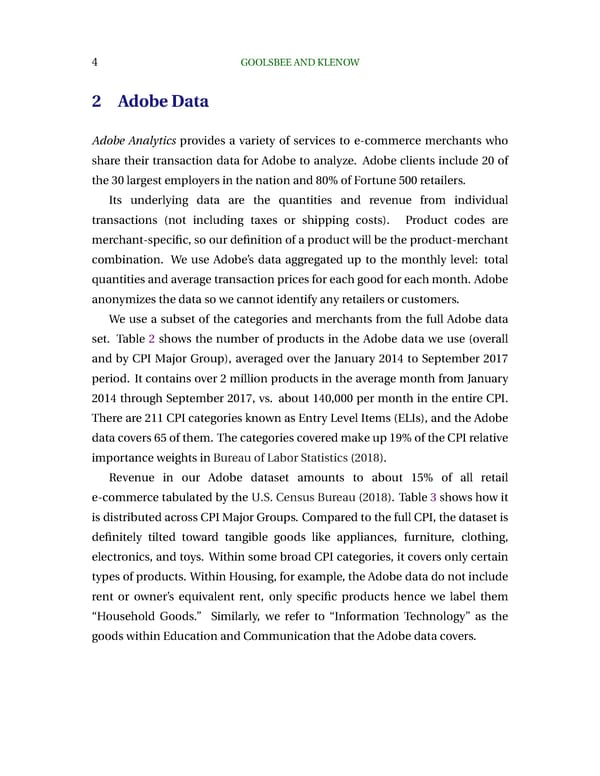4 GOOLSBEEANDKLENOW 2 AdobeData Adobe Analytics provides a variety of services to e-commerce merchants who share their transaction data for Adobe to analyze. Adobe clients include 20 of the30largestemployersinthenationand80%ofFortune500retailers. Its underlying data are the quantities and revenue from individual transactions (not including taxes or shipping costs). Product codes are merchant-specific,soourdefinitionofaproductwillbetheproduct-merchant combination. We use Adobe’s data aggregated up to the monthly level: total quantitiesandaveragetransactionpricesforeachgoodforeachmonth. Adobe anonymizesthedatasowecannotidentifyanyretailersorcustomers. Weuseasubset of the categories and merchants from the full Adobe data set. Table 2 shows the number of products in the Adobe data we use (overall and by CPI Major Group), averaged over the January 2014 to September 2017 period. It contains over 2 million products in the average month from January 2014 through September 2017, vs. about 140,000 per month in the entire CPI. Thereare211CPIcategoriesknownasEntryLevelItems(ELIs),andtheAdobe datacovers65ofthem. Thecategoriescoveredmakeup19%oftheCPIrelative importanceweightsinBureauofLaborStatistics(2018). Revenue in our Adobe dataset amounts to about 15% of all retail e-commercetabulatedbytheU.S.CensusBureau(2018). Table3showshowit is distributed across CPI Major Groups. ComparedtothefullCPI,thedatasetis definitely tilted toward tangible goods like appliances, furniture, clothing, electronics, and toys. Within some broad CPI categories, it covers only certain typesofproducts. WithinHousing,forexample,theAdobedatadonotinclude rent or owner’s equivalent rent, only specific products hence we label them “Household Goods.” Similarly, we refer to “Information Technology” as the goodswithinEducationandCommunicationthattheAdobedatacovers.
 Internet Rising, Prices Falling Page 3 Page 5
Internet Rising, Prices Falling Page 3 Page 5